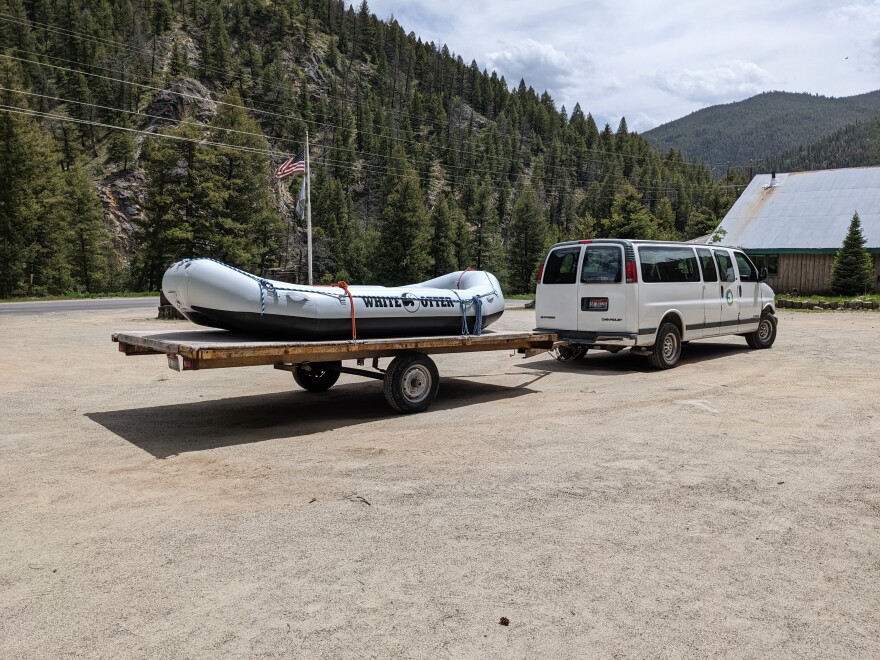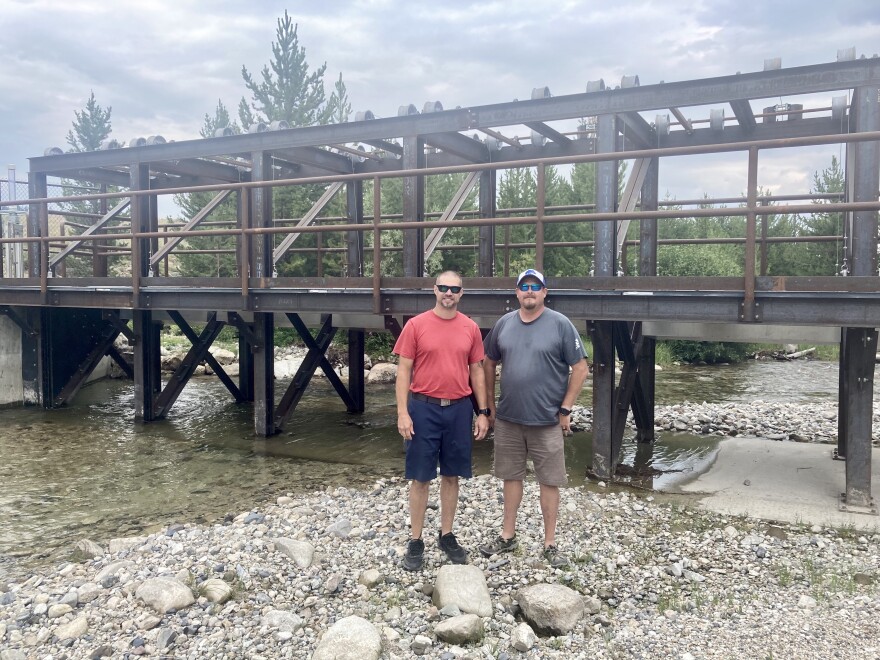See the whole series on 50 years of the Sawtooth National Recreation Area.
On any given summer weekend, you can find more people at Redfish Lake than almost anywhere else in central Idaho.
The largest lake in the Sawtooth National Recreation Area, its shorelines are often filled with campers, paddle-boarders and boaters.
Visits to the SNRA nearly doubled between 2015 and 2020 — from short of half a million to nearly 800,000. The boost, caused by a pandemic scurry to remote, outdoor places, has since eased according to the Forest Service, though official counts are only done every five years.
And while recreation is how most people experience the Sawtooth National Recreation Area, it's not the Forest Service's only focus there — not even the main one, according to Kirk Flannigan, the area ranger of the SNRA.
When Congress created the area 50 years ago, it handed the agency a specific law: Public Law 92-400. It tells the Forest Service how to manage the area according to six key values: natural, scenic, historic, pastoral, fish and wildlife.
But the top priority, Flannigan said, is in section two of the law.
"It says, 'The priorities for management of the Sawtooth NRA are 1. The protection and conservation of salmon and other fisheries.'"
He said that could be interpreted to mean the preservation of salmon is the centerpiece for the SNRA.

"You might not see that on the surface when you're going out to some of these areas, but [salmon] is, a lot of times, the driver of why we're doing what we're doing," Flannigan said.
That includes why the Forest Service might move a bridge or adjust a campsite location.
They are the soul of the SNRA
Ed Cannady, the former backcountry recreation manager for the SNRA, stood beside the Salmon River at one of the most common Chinook spawning grounds.
From its headwaters near Galena Pass, the river flows through the Sawtooth Valley, providing prime habitat for Chinook and sockeye salmon.
The fish are anadromous, born in cold, mountain fresh water — Chinook in the riverbeds, sockeye in the alpine lakes.
“If these fish didn't exist and a science fiction writer wrote the story of what they actually do, people wouldn't believe it," Cannady said.
Their bodies change, preparing them to survive in the saltwater ocean, and then the current carries them to sea — more than 900 miles.

"They spend two, three, four or even five years in the ocean, and then, somehow — they're maybe in the Gulf of Alaska — magically, something tells them, it's time to go home," Cannady explained. "Something very deep in their evolutionary DNA.”
So they come all the way back to the Stanley Basin, climbing 6,500 feet in elevation. It's the farthest inland and highest elevation sockeye spawning grounds in the world. Shortly after laying their eggs in nests called redds, they die.
“All of that nutrient composition in that salmon carcass becomes a part of this ecological process," said Daniel Stone, a policy analyst for the Shoshone-Bannock Tribes' Fish and Wildlife Department.
Those dead salmon are like a nutrient pump of nitrogen and phosphorus straight from the Pacific Ocean, Stone said, feeding eagles, wolves and lush meadows alike.
"Everything that you see today was the product of tens and tens of thousands of years of salmon leaving the Sawtooths, becoming large in the ocean and coming back and dying on those stream beds," he said.
The fish in the Sawtooths sustained generations of Shoshone-Bannock society and the Tribes' culture.

According to Idaho Fish and Game, about 25,000 sockeye would returned to the Sawtooth Valley in the 1880s. The fish were once so plentiful, Redfish Lake would apparently glow from their bright red bodies.
But dams built in the early 1900s began blocking them on their journeys. So by 1990, when the Shoshone-Bannock Tribes petitioned for sockeye to be listed under the Endangered Species Act, no adults at all returned to Redfish from the ocean. Two years later, just one returned: Lonesome Larry.
“If we lose the salmon," Cannady said, "we lose the soul. They are the soul of the SNRA. They connect the SNRA to the greater world.”
Pristine habitat
Doug Fenn co-owns White Otter Outdoor Adventures with his wife Nancy. They run rafting trips on the day stretch of the Upper Salmon River, as well as other river activities.
Fenn was a guide for the company in the 90s when sockeye, and later Chinook, were listed.
“As a guide, you recognized that we were seeing less and less fish every year," he said.
After the listings, the Forest Service introduced new rules to protect Chinook. In late August, the guides and tourists would have to carry their boats out of the water at a few popular spawning sites. For much of September, the river closed.
Sawtooth NRA will implement restrictions on Upper Main Salmon River beginning Aug 15. Each summer, these restrictions provide Chinook salmon their best chance to successfully spawn. Please keep your distance, avoid wading in the river, throwing rocks, or making loud noises. pic.twitter.com/o1RalNeRo9
— Sawtooth NF (@SawtoothNatlFS) August 12, 2022
Fenn said this angered the original owners of the guiding companies, in part, because it effectively changed their seasons — they used to operate into October.
“You couldn't afford to pay the bills to keep people hired, so it just became the most cost-effective thing to shut down," he said.
Though some of the rules remain, Fenn said the businesses have since adjusted and tensions have eased. River guides are often the ones who tell the salmon story to thousands of tourists who’ve never heard it before.
"You get the feeling that every time you show somebody this river, or they have this experience, they understand why it's important to protect it," he said.
As the guides paddle the boats through rapids, they tell visitors that the biggest threats to the fish in the Sawtooth National Recreation Area are things like climate change and the four lower Snake River dams.
“We still have some of this pristine habitat," Fenn said. "If fish were allowed to get back here in numbers, they'd actually thrive.”

Idaho’s Republicans, including Gov. Brad Little, staunchly reject dam breaching. They say it would be detrimental to Idaho’s economy.,
But Cong. Mike Simpson (R-Idaho) has broken from the mold.
“I tell people all the time, 'If you've got a better idea, if you've got a better way to save salmon, let me know,'” Simpson said.
Last year, he proposed taking out the dams while giving money to the industries like agriculture, that depend on them.
“So far, nobody's come up with an idea. Because we have tried everything else. and we have spent $17 billion trying to get salmon past these dams," he said. "And guess what? Hasn't worked so far."
It's hopeful now
The Shoshone-Bannock Tribes share the position that taking the dams out would make the biggest difference for salmon returning. In the meantime, the Tribes' Fish and Wildlife Department is working to make the Sawtooth Valley as hospitable for the fish as possible.
"Every morning, we’ll come out here, check traps, and do what we need to do with the sockeye, which may include PIT tagging or fin clipping," said Rob Trahant, a Shoshone-Bannock tribal member and a senior fisheries technician.
Alongside Kurt Tardy, the sockeye program manager, Trahant stood on the Tribes’ new research station at a creek flowing out of Pettit Lake, south of Redfish.
It’s called a weir and looks like a covered bridge that traps fish in boxes hanging in the water. The fisheries program uses it to track the population and improve recovery efforts.

Idaho Fish and Game hatcheries release about a million young fish each year in lakes and streams to migrate to the ocean.
But the Tribes’ focus is on natural salmon—adults that dig their own redds and lay eggs in the lakes.
“We want as much on-the-ground production in the lake as possible to allow that natural gene flow to occur over time, to be able to create a distinguishable Pettit Lake stock," Tardy said.
Idaho Fish and Game does some natural production, too. And the Tribes' program at Pettit Lake builds on a multi-agency effort to preserve the genetic profile of the few sockeye that returned to the basin in the 90s.
Tardy said the naturally-spawning fish tend to have better survival rates than the hatchery ones. The goal is to eventually see all the alpine lakes in the basin naturally producing salmon again.
Two years ago, a sockeye that was born in the lake and traveled to the ocean made it back to Pettit. It was the first time in 30 years that had happened.
Trahant, who had worked on the recovery program nearly all that time, released the fish himself.
“My babies came home, I guess I could say that," he said. "Been here for so long that it's just nice to see fish coming back.
Thirty-seven adult fish ended up returning.
Last year, nearly 10,000 wild juveniles born in Pettit passed under the weir on their way to the ocean. If the return rate follows trends, 100 could come back next year.
“It's very hopeful now," Trahant said.
As a tribal member, he may never be able to fish for sockeye in the Stanley Basin in his lifetime. But, maybe his grandkids will.
“It's the future, right?" he said. "That's what we want them back for.”
Find reporter Rachel Cohen on Twitter @racheld_cohen
Copyright 2022 Boise State Public Radio





